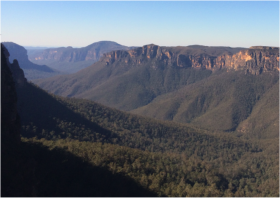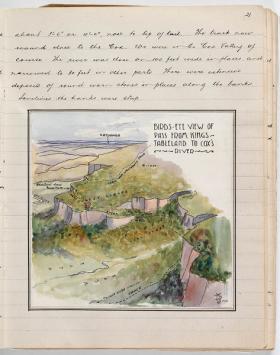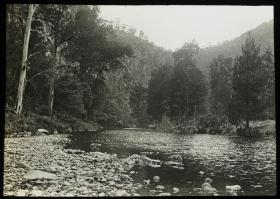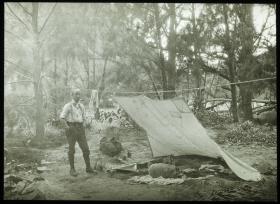Places are similar and different: Blue Mountains
Key inquiry question #1
How and why are places similar and different?
Key inquiry question #2
How do people’s perceptions about places influence their views about the protection of places?
Content Summary
The Australian continent
Students:
- investigate Australia’s major natural and human features for example: (ACHGK014, ACHGK015)
- description of natural features of Australia (ie. deserts, rivers, mountains).
Perception and protection of places
Students:
- investigate how the protection of places is influenced by people’s perception of places, for example: (ACHGK018)
- description of how and why people perceive places differently
- discussion of how people’s perceptions influence the protection of places in Australia (ie.sacred sites, national parks, world heritage sites)
Background Notes for Teachers
Greater Blue Mountains World Heritage Area
“The Greater Blue Mountains is an area of breathtaking views, rugged tablelands, sheer cliffs, deep, inaccessible valleys and swamps teeming with life. The unique plants and animals that live in this outstanding natural place relate an extraordinary story of Australia's antiquity, its diversity of life and its superlative beauty. This is the story of the evolution of Australia's unique eucalypt vegetation and its associated communities, plants and animals.” Greater Blue Mountains: Inscribed on the Heritage List in 2000
Myles Dunphy – the father of conservation
“In 1933 Dunphy had helped to form … the National Parks and Primitive Areas Council, which sought the reservation of scenic areas for recreation. He looked enviously on the development of national parks in the United States of America and hoped to encourage similarly protected environments in New South Wales for bushwalkers. As secretary of the NP&PAC, in 1934 Dunphy publicised a proposal for a Blue Mountains national park that had been submitted in 1932, but it was not until 1959 that lobbying resulted in a government gazettal of 155,676 acres (63,000 ha). This park was only a quarter of the size envisioned by Dunphy but with subsequent additions, such as the Wollemi National Park in 1979, the eventual Greater Blue Mountains Park fulfilled his original proposal.”
“Displaying a lifelong commitment to connecting urban residents with the natural world, Dunphy made a profound contribution to the conservation cause. `Whether we like it or not’, he had commented in 1934, `we hold our land in trust for our successors’. His skill as a cartographer and his role as a lobbyist ensured that land was preserved for his successors to enjoy. His trail (literally) can still be followed.” Australian Dictionary of Biography
Student Activities
Greater Blue Mountains World Heritage Area
Students map and locate areas within the Blue Mountains National Park as well as viewing photos of the bushland and mountains across time periods to see how they have been protected.

Myles Dunphy collection
Students examine maps and photos of Blue Mountains and research the reasons why Myles Dunphy proposed a National Park for large parts of the Blue Mountains area.

Perceptions of Myles Dunphy
Students look at photos of Myles Dunphy in the Blue Mountains and then imagine themselves in his position.

National park brochure
Students create a compelling mock brochure or web page detailing an area of the Blue Mountains

Resources
Picture books
The Bushwalk by Sandra Kendell
Leaf Litter by Rachel Tonkin
In the Bush: Our Holiday at Wombat Flat by Roland Harvey
Videos
Landforms of the Blue Mountains
Sources
Bush pram and dog boots, Myles Dunphy collection, Australian National Museum
Websites
Great Blue Mountains: Inscribed in the World Heritage Area in 200 – fact sheet
NSW Syllabus for the Australian Curriculum Geography K–6
A student:
- GE2-1 examines features and characteristics of places and environments
- GE2-2 describes the ways people, places and environments interact
- GE2-3 examines differing perceptions about the management of places and environments
- GE2-4 acquires and communicates geographical information using geographical tools for inquiry
Acquiring geographical information
- develop geographical questions to investigate (ACHGS019, ACHGS026)
- collect and record relevant geographical data and information, for example, by observing, by interviewing, conducting surveys, or using maps, visual representations, the media or the internet (ACHGS020, ACHGS027)
Processing geographical information
- represent data by constructing tables, graphs and maps (ACHGS021, ACHGS028)
- represent information by constructing large-scale maps that conform to cartographic conventions, using spatial technologies as appropriate (ACHGS022, ACHGS029)
- interpret geographical data to identify distributions and patterns and draw conclusions (ACHGS023, ACHGS030)
Communicating geographical information
- present findings in a range of communication forms, for example, written, oral, digital, graphic, tabular and visual, and use geographical terminology (ACHGS024, ACHGS031)
- reflect on their learning to propose individual action in response to a contemporary geographical challenge and identify the expected effects of the proposal (ACHGS025, ACHGS032)
- Place: the significance of places and what they are like (ie. natural and human features and characteristics of different places and their similarities and differences; how people’s perceptions about places influence their responses and actions to protect them).
- Space: the significance of location and spatial distribution, and ways people organise and manage spaces that we live in (ie. settlement patterns within Australia, neighbouring countries and other countries).
- Environment: the significance of the environment in human life, and the important interrelationships between humans and the environment (ie. how climate and environment influence settlement patterns; interconnections between people and environments; differing ways people can use environments sustainably).
- Interconnection: no object of geographical study can be viewed in isolation (ie. interconnections between people, places and environments; influence of people’s values on the management and protection of places and environments and the custodial responsibilities of Aboriginal and Torres Strait Islander Peoples).
- Scale: the way that geographical phenomena and problems can be examined at different spatial levels (ie. types of settlement across a range of scales; the influence of climate across a range of scales).
- Sustainability: the capacity of the environment to continue to support our lives and the lives of other living creatures into the future (ie.ways in which people, including Aboriginal and Torres Strait Islander Peoples, use and protect natural resources; differing views about environmental sustainability; sustainable management of waste).
Learning across the curriculum
- Sustainability
- Ethical understanding
- Literacy
- Personal and social capability
- Civics and citizenship